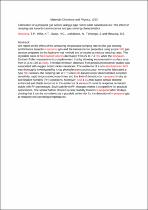 ResearchSpace
ResearchSpace
Fabrication of a propanol gas sensor using p-type nickel oxide nanostructures: The effect of ramping rate towards luminescence and gas sensing characteristics
JavaScript is disabled for your browser. Some features of this site may not work without it.
- ResearchSpace
- →
- Research Publications/Outputs
- →
- Journal Articles
- →
- View Item
| dc.contributor.author |
Mokoena, Teboho P

|
|
| dc.contributor.author |
Hillie, Kenneth T

|
|
| dc.contributor.author |
Swart, HC

|
|
| dc.contributor.author |
Leshabane, N

|
|
| dc.contributor.author |
Tshilongo, J

|
|
| dc.contributor.author |
Motaung, DE

|
|
| dc.date.accessioned | 2020-10-05T08:52:34Z | |
| dc.date.available | 2020-10-05T08:52:34Z | |
| dc.date.issued | 2020-10 | |
| dc.identifier.citation | Mokoena, T.P. (et.al). 2020 Fabrication of a propanol gas sensor using p-type nickel oxide nanostructures: The effect of ramping rate towards luminescence and gas sensing characteristics. Materials Chemistry and Physics, v253, 15pp. | en_US |
| dc.identifier.issn | 0254-0584 | |
| dc.identifier.issn | 1879-3312 | |
| dc.identifier.uri | https://www.sciencedirect.com/science/article/pii/S0254058420306866 | |
| dc.identifier.uri | https://doi.org/10.1016/j.matchemphys.2020.123316 | |
| dc.identifier.uri | http://hdl.handle.net/10204/11590 | |
| dc.description | Copyright: 2020 Elsevier. This is the abstract version of the work. For access to the fulltext version, kindly visit the publisher's website. | en_US |
| dc.description.abstract | We report on the effect of the annealing temperature ramping rate on the gas sensing performance towards n-propanol gas and the luminescence properties using p-type NiO gas sensors prepared by the hydrothermal method and annealed at various ramping rates. The crystallite sizes of NiO nanostructures decreased from 22 to 7.4 nm, while the Brunauer–Emmett–Teller measurements complemented that by showing improvement in surface area from 0.15 to 129.11 m2/g. The blue emission observed from photoluminescence studies was associated with oxygen and/or nickel vacancies. The existence of a non-stoichiometric NiO was thoroughly investigated by x-ray photoelectron spectroscopy. Among the fabricated p-type NiO sensors, the ramping rate of 1 °C/min NiO-based sensor demonstrated excellent sensitivity, rapid response/recovery times and low limit of detection to n-propanol in dry air and relative humidity (RH) conditions. Moreover, NiO-1 oC/min-based sensor showed enhanced and stable response in the existence of various RH and its response remained stable with RH percentage. Such stability to RH changes makes it competitive for practical applications. The sensor further showed a clear stability towards n-propanol after 10 days, proving that it can be considered as a possible contender for the detection of n-propanol gas at relatively low operating temperatures. | en_US |
| dc.language.iso | en | en_US |
| dc.publisher | Elsevier | en_US |
| dc.relation.ispartofseries | Worklist;23763 | |
| dc.subject | Gas sensing | en_US |
| dc.subject | Luminescence | en_US |
| dc.subject | N-propanol | en_US |
| dc.subject | p-type NiO | en_US |
| dc.subject | Ramping rates | en_US |
| dc.title | Fabrication of a propanol gas sensor using p-type nickel oxide nanostructures: The effect of ramping rate towards luminescence and gas sensing characteristics | en_US |
| dc.type | Article | en_US |
| dc.identifier.apacitation | Mokoena, T. P., Hillie, K. T., Swart, H., Leshabane, N., Tshilongo, J., & Motaung, D. (2020). Fabrication of a propanol gas sensor using p-type nickel oxide nanostructures: The effect of ramping rate towards luminescence and gas sensing characteristics. http://hdl.handle.net/10204/11590 | en_ZA |
| dc.identifier.chicagocitation | Mokoena, Teboho P, Kenneth T Hillie, HC Swart, N Leshabane, J Tshilongo, and DE Motaung "Fabrication of a propanol gas sensor using p-type nickel oxide nanostructures: The effect of ramping rate towards luminescence and gas sensing characteristics." (2020) http://hdl.handle.net/10204/11590 | en_ZA |
| dc.identifier.vancouvercitation | Mokoena TP, Hillie KT, Swart H, Leshabane N, Tshilongo J, Motaung D. Fabrication of a propanol gas sensor using p-type nickel oxide nanostructures: The effect of ramping rate towards luminescence and gas sensing characteristics. 2020; http://hdl.handle.net/10204/11590. | en_ZA |
| dc.identifier.ris | TY - Article AU - Mokoena, Teboho P AU - Hillie, Kenneth T AU - Swart, HC AU - Leshabane, N AU - Tshilongo, J AU - Motaung, DE AB - We report on the effect of the annealing temperature ramping rate on the gas sensing performance towards n-propanol gas and the luminescence properties using p-type NiO gas sensors prepared by the hydrothermal method and annealed at various ramping rates. The crystallite sizes of NiO nanostructures decreased from 22 to 7.4 nm, while the Brunauer–Emmett–Teller measurements complemented that by showing improvement in surface area from 0.15 to 129.11 m2/g. The blue emission observed from photoluminescence studies was associated with oxygen and/or nickel vacancies. The existence of a non-stoichiometric NiO was thoroughly investigated by x-ray photoelectron spectroscopy. Among the fabricated p-type NiO sensors, the ramping rate of 1 °C/min NiO-based sensor demonstrated excellent sensitivity, rapid response/recovery times and low limit of detection to n-propanol in dry air and relative humidity (RH) conditions. Moreover, NiO-1 oC/min-based sensor showed enhanced and stable response in the existence of various RH and its response remained stable with RH percentage. Such stability to RH changes makes it competitive for practical applications. The sensor further showed a clear stability towards n-propanol after 10 days, proving that it can be considered as a possible contender for the detection of n-propanol gas at relatively low operating temperatures. DA - 2020-10 DB - ResearchSpace DP - CSIR KW - Gas sensing KW - Luminescence KW - N-propanol KW - p-type NiO KW - Ramping rates LK - https://researchspace.csir.co.za PY - 2020 SM - 0254-0584 SM - 1879-3312 T1 - Fabrication of a propanol gas sensor using p-type nickel oxide nanostructures: The effect of ramping rate towards luminescence and gas sensing characteristics TI - Fabrication of a propanol gas sensor using p-type nickel oxide nanostructures: The effect of ramping rate towards luminescence and gas sensing characteristics UR - http://hdl.handle.net/10204/11590 ER - | en_ZA |





